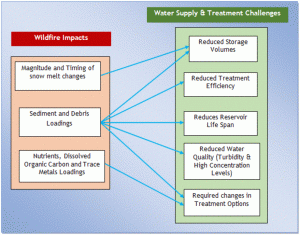Wildfire Implications on Drinking Water Treatment processes
Communities are in demand for safe drinking water from Distribution Utilities. However, this is hindered by unpredictable wildfire that requires prior establishment of treatment-plant specific strategies for treating highly degraded source water. It is a continuing challenge for water distribution utilities because of the following reasons reported by USGS (2018) and summarized in figure 5. Dissolved manganese concentration in reservoirs leads to higher treatment costs to meet drinking water quality standards (Martin, 2016). The presence of dissolved organic carbon (DOC) contributes to water discoloration hence more chlorine to achieve adequate disinfection. Metals found in the dissolved phase or attached to suspended sediment always need advanced water-treatment processes (Martin, 2016).

Figure 5: Wildfire impacts on Drinking water supply
